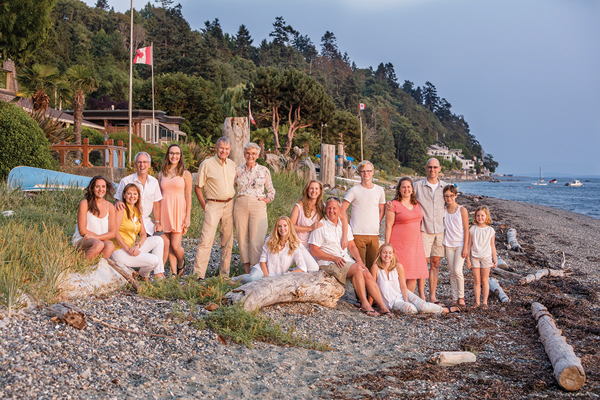by Don MacGregor, Texas School Instructor
Environmental portraits, carefully designed and crafted, can create significant purchasing desire and ultimately higher sales. This style captures the essence of a family balanced with the beauty of the world we live in. Further, this style of portrait is ideal for enhancing the decor of a home (wall portraits). The photographers vision must combine the environment with the family…first and foremost, which is best done by bringing the family into the foreground of the composition.
The approach is very professional in that it is an engineered vision with composition and lighting skills that the public can’t do.
1. Consultation with clients to determine:
- Style of session (casual or formal, classic or relationship)
- Location (linked to image concept)
- Time of day (natural light control or flash)
- Clothing (linked to concept and each person in balance)
- Display options (pre-framing the potential sale)
- People involved (number, ages and relationship)2. The photographer must preplan the session:
- Lighting and equipment required
- Background choice, details that contribute to composition
Potential posing of people involved
Pre planning the session is exactly what commercial photographers do and their work is stunning artistically and technically. In all cases one has to be fluid and prepared to modify a plan but at least there is a plan in place. Another positive for pre-planning is it allows the photographer to interact with the people and build rapport which of course establishes winning expressions. Expressions are ultimately what people look at (think about your own experience when seeing yourself in a photograph). Also, pre planning allows you the ability to quickly solve any technical issues like exposure or lighting problems. It is critical to show your client that you are completely confident and professional.
I arrived several hours before the session to explore the beaches in the area and try to determine exactly where the sun would go down as that would impact camera angle and the background. My vision was to have two concepts. One a classic “full face” composition and also a relationship style. To be successful with this kind of session, you have to have a game plan and an back up. As I walked about I looked for interesting natural scenes and tried to “see” potential portraits with the family and of course consider what conditions I would have in terms of lighting. I determined several options and decided all I needed was my B1 (Profoto) for lighting gear.
Meeting the family is important. You have to take control and have them embrace your ideas and that is done with enthusiasm and an explanation of what is going to happen and why you have chosen various locations. By talking with enthusiasm and describing your vision (don’t just say it is going to be beautiful … explain the composition and WHY it will be beautiful), your clients will buy into the project and that goes a long way to increase purchasing desire and making the sales process easier.
I chose the location based on the setting sun and the background. We would still be in hard light so the goal was to back light the family. Exposure readings defined that the highlight exposure (and overall scene) was significantly greater than the shadow side. Flash was brought in from camera left to increase exposure to the shadow side such that it was roughly 1.5 stops less than the highlight side. A lot of post production work in LR and PS that took about an hour managed the difference in exposure. Note that we put the clothing with the strongest issue (pattern) in the center.
While hiking one day, I saw another opportunity that had potential. In the image on the right, the light and contrast at the scout time made the situation look awful. I realized that the sun would set to camera right and would slowly lower the contrast issue and planned this as close to sunset as possible. The composition strength is the diagonal line of the rock wall and the repetition of the posing of the family with that natural element. The family had NO light on them and everything was flat. The B1 provided light on their faces and was approximately 40 feet from the subjects. It metered as contributing approximately 40% to the final exposure. That means a gentle main light with good detail in faces.
In the image on the title page, the sun was basically down and the subjects were not effected by the natural conditions because they were in deep shade. There was no light on their faces but the “scene” looked great. Flash was introduced such that it was approximately one stop less than the ambient scene. Matching the scene brightness (faces) would not look real. They should appear a bit darker than normal in this situation. Of course, all of the images shown here have had serious post production work (retouching) and that is now the normal approach for a professional image.
